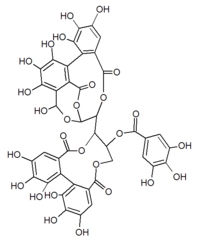Casuarinin
| Casuarinin | ||
|---|---|---|
 | ||
| Other names Stachyurin | ||
| Identifiers | ||
| CAS number | 79786-01-9, 81739-27-7 | |
| PubChem | 157395 | |
| Jmol-3D images | Image 1 | |
| ||
| ||
| Properties | ||
| Molecular formula | C41H28O26 | |
| Molar mass | 936.64 g/mol | |
| Except where noted otherwise, data are given for materials in their standard state (at 25 °C (77 °F), 100 kPa) | ||
| Infobox references | ||
Casuarinin is an ellagitannin. It is found in the pericarp of pomegranates (Punica granatum). It is also found in Casuarina and Stachyurus species[1] and in Alnus sieboldiana.[2]
It is an isomer of casuarictin. It is a highly active carbonic anhydrase inhibitors.[3]
Biosynthesis
In some plants including oak and chestnut, the ellagitannins are formed from 1,2,3,4,6-pentagalloyl-glucose and further elaborated via oxidative dehydrogenation (tellimagrandin II and casuarictin formations). After conversion of casuarictin to pedunculagin, the pyranose ring of the glucose opens and the family of compounds including casuariin, casuarinin, castalagin, and castlin, vescalagin and vescalin forms.[4]
References
- ↑ Okuda, T.; T. Yoshida, M. Ashida and K. Yazaki (1983). "Tannins of Casuarina and Stachyurus species. I: Structures of pendunculagin, casuarictin, strictinin, casuarinin, casuariin, and stachyurin.". Journal of the Chemical Society (8): 1765–1772.
- ↑ Structures of alnusiin and bicornin, new hydrolyzable tannins having a monolactonized tergalloyl group. Yoshida T, Yazaki K, Memon M.U, Maruyama I, Kurokawa K, Shingu T and Okuda T, Chemical and pharmaceutical bulletin, 1989, volume 37, number 10, pages 2655-2660, INIST:19467830 (abstract)
- ↑ Satomi, H.; Umemura, K.; Ueno, A.; Hatano, T.; Okuda, T.; Noro, T. (1993). "Carbonic anhydrase inhibitors from the pericarps of Punica granatum L". Biological & Pharmaceutical Bulletin 16 (8): 787–790. doi:10.1248/bpb.16.787. PMID 8220326.
- ↑ Tannins chemistry by Hagerman A. E.
| |||||||||||||||||||||||||||